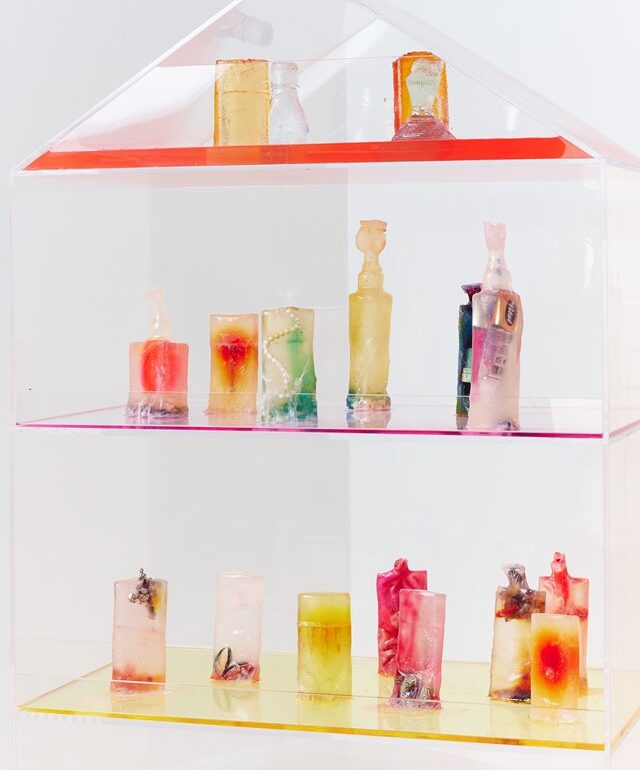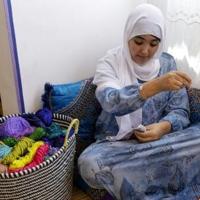As her new exhibition opens at Dries Van Noten’s gallery space in LA, Julia Thompson discusses the meaning behind her mesmerising sculptures
Canadian artist Julia Thompson’s piercingly vulnerable practice flows with the material flux of living experiences – heartbreak, addiction, grief, desire – instinctively and unwillingly from the body. For her latest show, Valley of the Dolls at Dries Van Noten’s The Little House, Thompson returns to her adopted hometown of Los Angeles, a place sticky with memories of her youth. “I spent six years of my twenties there, swimming in this pool of people chasing fame, money, status,” reflects Thompson. “In LA, desire is so prevalent. And desire is scary and terrifying, especially when you’re a young woman living so much from your body.” Her exhibition asks, “What would it mean if women’s desire actually had a place in the world? What does it mean to desire something with that cruelty of knowing it will never be fulfilled?”
Thompson never intended to be an artist; she studied fashion at Parsons in New York before a teacher suggested she pivot to a fine arts practice to actively engage with her fascination for the materiality of the incorporeal. “I was making clothes from a young age, but they were so abstract,” she laughs. “Weird plastic T-shirts with pockets of water and dye, so stiff you couldn’t walk in them. But I guess it’s the same things I’m interested in now.” From the outset, her work has been anchored in the translation of her inner emotional landscape to a tangible, relatable medium, yet it’s been an ongoing negotiation as to how to invite others into it. “Once you actually make yourself vulnerable, that’s a power, and then it creates an entry point for others to access your work,” she reflects. “I guess over the last ten years I’ve really been grappling with how to make the work material and also personal, but not so much about me that it closes people off.”
After a period of working with resin – a more commercially viable material – Thompson has returned to “the perishable, the decaying, the sticky materials that genuinely excite me.” Her sculptures in Valley of the Dolls are made from wax, soap, vodka, eye shadow, and lipstick – unstable materials that react to time, environment, touch, and even the presence of bodies around them. “The bottom line is I can be really vulnerable through the materiality of it, the ways it falls apart and moves,” explains Thompson. “How I understand memory, it’s always changing, yet my anxiety is always in control. So, to put a label on it, I think I’m actually shooting myself in the foot.” In trusting the materials she works with, there’s a liberation in knowing she can only manipulate them to an extent before external circumstances take over. “As much as we try to control everything, like even a memory … memory can be a thing and move and collapse with time,” she reflects.

Valley of the Dolls, which is curated by Mercedes Goméz of Coma Art Services, seams the overlap of Thompson’s personal experience and the larger ecosystem of Los Angeles where the exhibition takes place. With sculpture, drawing, and video, the site-specific installation centres around three “doll houses” crafted from clear and pink plexiglass. Filled with her soap and wax sculptures, these containers are envisaged as generic utopian dreams of the purity of youth – until reality permeates their innocent fiction. “I like them being in pseudo containers which then leak and spill,” she explains. “We can set up all of these protective environments but then the weather outside always makes it way in.” Hangovers, hormones and heartbreak fracture the seemingly glossy, puritan safe house in which women are expected to live.
Video by Hanna Moon
Although Thompson’s work is deeply rooted in the personal, her latest exhibition is a global rebuttal to the strictures of control that are imposed on women to then impose on themselves: emotionally, socially, and physically. By pouring out the pain of such self-judgment – and ultimately self-harm – into her decaying sculptures, there is a sigh of relief to be found in the resolve of being vulnerable as a woman and as a human. As the objects melt away through the plexiglass, there is a reminder that the painful knots of emotion, hormones and hear do not define us – we are constantly, beautifully in flux.
Valley of the Dolls by Julia Thompson is on show at Dries Van Noten’s The Little House in Los Angeles until 31 August 2024.
This post was originally published on this site be sure to check out more of their content








